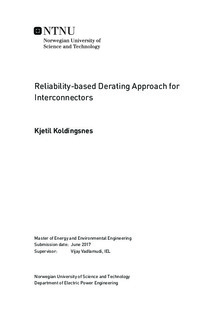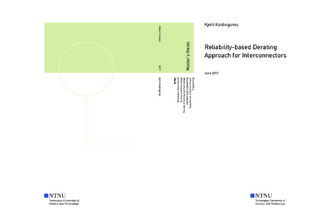| dc.description.abstract | This Masters project work has its genesis in the preliminary findings of a research collaboration in 2016 between the Department of Electric Power Engineering, NTNU, and Statnett (the Norwegian Transmission System Operator). As its overarching goal, the research proposition centred on developing a foundation for a suitable theoretical framework for one issue related to cross-border capacity auctions: interconnector adequacy. The motivation itself for such an undertaking stemmed from the divergent recommended approaches of estimating the capacity that the prospective UK-Norway interconnector (North-Sea Link) is allowed to bid into the UK Capacity Market.
Capacity made available through an interconnector for an area with a capacity mechanism in place, should be eligible to participate in the auctions to prevent market distortion and to ensure that correct investment signals are sent. There is also a need for a transparent and robust method to calculate the proportion of the rated interconnector capacity allowed to participate in market auctions. Such a methodology should consider and remunerate the interconnector's contribution to improved system adequacy in the importing area. In the NTNU-Statnett project, a unique reliability metric Interconnector Effective Load Carrying Capability (IELCC) was conceptualized for the purpose of probabilistic interconnector de-rating; preliminary results were demonstrated on a very simple interconnected test system with a simple load profile. IELCC was founded on Loss of Load Expectation (LOLE) quantification in the interconnected system, addressing the need for a reliability-based de-rating procedure, as opposed to other proposed approaches that focuses on empirical considerations such as price differentials.
This thesis examines the NTNU-Statnett project claim that obtaining the de-rated interconnector capacity using a probabilistic reliability framework is a well-argued approach. To corroborate the effectiveness of the IELCC metric, larger interconnected test systems (Roy Billinton Test Systems and IEEE Reliability Test Systems) with detailed load profiles have been deployed, and relevant sensitivity analyses have been conducted. Further, a new variant of IELCC, founded on Expected Energy Not Served (EENS) quantification in the interconnected system is posited, the results demonstrated on the aforementioned test systems and the implications investigated.
In a report by The Joint Research Centre of the European Commission from 2016, appropriate generation and system adequacy standards for the internal electricity market were identified. One of the recommendations of the study was to establish EENS as a preferred metric as it alone proves appropriate for the calculation of socially optimal levels of reserve . In light of this, the proposed EENS-based IELCC in this thesis is deemed to have significant application potential in cross-border capacity markets. | |

